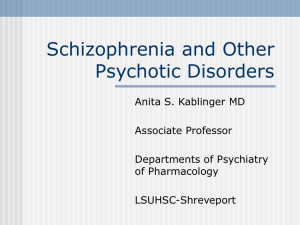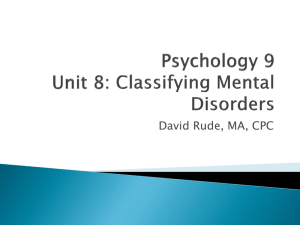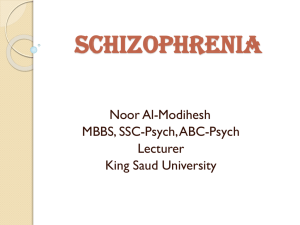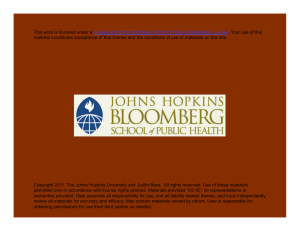Unit 12 * Abnormal Psychology and Treatment
advertisement
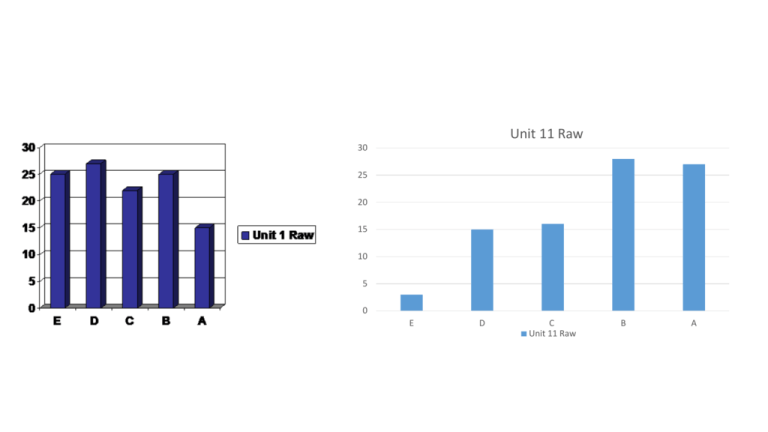
Unit 11 Raw 30 25 20 15 10 5 0 E D C Unit 11 Raw B A Unit 12 – Abnormal Psychology and Treatment Neurodevelopmental Disorders Schizophrenic Spectrum Disorders Bipolar Disorders Depressive Disorders Anxiety Disorders Chronic vs. episodic • Chronic = long lasting and over time • Episodic = varied lengths of episodes, not consistent Neurodevelopmental • ASD • Social communication disorder • Specific Learning Disorder • ADHD • Intellectual disability Schizophrenia Spectrum • Disorders based on an error of selective attention • What is selective attention? Delusions and Hallucinations • Delusions – irrational, unjustifiable, usually paranoid belief • Delusions of grandeur – “I am King Louis XIV!!” • Delusions of persecution – “The government is after me!!” • Hallucinations – perception of nonexistent, external stimuli • Can be visual or auditory • MOST are auditory Disorganized Speech • Frequent derailment or incoherent speech • Ex: Word salad • “The potato snake ate the sun spotted dinosaur cupholder of unique!” Grossly disorganized or abnormal motor: • Jerky movements, atypical behavior Negative Symptoms • Remember negative means TAKING SOMETHING AWAY • Catatonia – flat affect (like no one is home) • All emotion is taken out, person lacks all energy • Positive symptoms – adding a symptom (i.e. hallucinations or delusions) Specifiers of Schizophrenia Paranoid preoccupations with delusions and hallucinations. Catatonic immobility or excessive purposeless movements. Disorganized disorganized speech or behavior, inappropriate emotions. Word Salads: scrambled or nonsensical speech. symptoms, but doesn't fit above models. Undifferentiated Residual Withdrawal, after hallucinations and delusions have disappeared Causes of Schizophrenia • Psychological - triggering experiences, genes predisposed but some react to traumatic triggers by developing schizophrenia. • They vary. Biochemical Causes • Prenatal: It is also thought to perhaps be triggered or caused by the introduction of a prenatal virus that affects brain development, possibly in the thalamus. • People conceived in winter months are more apt to develop schizophrenia in Northern hemisphere, while the reverse is true in the Southern. • Drug use: Amphetamines and cocaine sometimes intensify symptoms. • Dopamine is also associated with physical movement, disruption of is associated with schizophrenia. • Brain anatomy:they have abnormal brain tissue, low frontal lobe activity. • Thalamus: reactions are smaller than normal and are reactive--that may cause brain overstimulation. Rule of Thirds • 1/3 of people who develop schizophrenia only have one episode • 1/3 have reoccurring episodes • 1/3 are chronic with unremitting symptoms. Genetic Factors • Definite genetic link: the closer you are genetically to someone with Schizophrenia, the more likely you are to get it. • 1 in 100 people get it. • 1 in 10 of siblings • 1 in 2 identical twins, even if raised apart Dopamine Hypothesis • Biochemical: 6 times the normal amount of dopamine receptors that increase brain activity to manic levels. • Thus dopamine blockers reduce symptoms. Bipolar and related disorders (previous manic depressive) • alternates between hopelessness and lethargy of depression and over-excited manic state. • Mania - typically over-talkative; overactive; little or no sleep; highly impulsive, loud, flighty, hard to interrupt sexually less-inhibited. Grandiose optimism and self-esteem. May be very irritable. • High levels of norepinephrine found • Hyper vs. hypo? • After mania, people fall back to either a normal state or into a depressed state Bipolar - Causes • Genetic: tends to run in families, genetic predisposition • Biological: serotonin, dopamine, and norepinephrine don’t function properly • Environmental: stress, major life event • Genetic expression Bipolar 1 • Classic type of bipolar • Individuals experience both manic and depressive episodes at varying lengths Bipolar 2 • Involves less severe manic episodes, depressive episodes are the same Differences? • Bipolar 1 is more severe than bipolar 2. • They used to be mood disorders, but mania is not based in emotion – it’s based more in a possible delusional state where the person may take on a new identity. • Florida case Depressive Disorders (previously mood disorders) • Disorders related to emotions Major Depressive Disorder • two or more weeks of depressed mood, intense feelings of worthlessness and hopelessness; and diminished interest in things that were once considered pleasurable. • People feel like they are in a deep black hole with no way to get out. The hopeless feeling often prevents them from seeing any reason to try to get out. Very dangerous illness. Persistent Depressive Disorder • Also called dysthymia • chronic low level depression lasting for at least 2 years; the feelings aren't as intense, but they last longer. Difficult to detect because of the lack of intensity but takes a large toll on body and psychology systems. Premenstrual dysphoric disorder • Symptoms of menstrual cycles do not improve following menses • PMS is chronic • Examples? Anxiety Disorders • Disorders related to autonomic nervous system abnormalities (possible endocrinology states) Psychoanalytic repressed feelings during childhood symbolized by trigger. Behavioral Biological learned fear, which has been reinforced, or social learning, imitating others who has fear like parents. May be generalized from other learned experiences-one dog to all dogs. predisposed genetically to be afraid of things that can cause death: snakes, spiders, height, enclosed places, disease. GAD Persistent symptoms of an excited sympathetic, nervous system: sweating, heart racing, dizziness, shaky accompanied by persistent negative feelings and fear…not triggered by specific events. Specific Phobia persistent, irrational fear of a specific object of situation – key feature is the presence of a phobic stimulus Panic Disorder unpredictable, minutes long intense anxiety attack, as if you're going to be killed any second, but no specific, real threat is apparent. Agoraphobia The individual fears or avoids situations because the thought of escape might be difficult or help may not be available Social Anxiety Disorder Social phobia – fear/distress over social situations Separation Anxiety Disorder Consistent fear from separation from home or attachment figures Selective Mutism Individuals may fail to speak because of fear of negative evaluation


